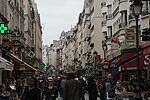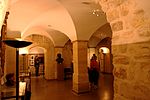Sentier (Paris Métro)
Paris Métro line 3Paris Métro stations in the 2nd arrondissement of ParisRailway stations in France opened in 1904

Sentier (French pronunciation: [sɑ̃tje]) is a station on Line 3 of the Paris Métro in the 2nd arrondissement.
Excerpt from the Wikipedia article Sentier (Paris Métro) (License: CC BY-SA 3.0, Authors, Images).Sentier (Paris Métro)
Rue d'Aboukir, Paris 2nd Arrondissement (Paris)
Geographical coordinates (GPS) Address Nearby Places Show on map
Geographical coordinates (GPS)
| Latitude | Longitude |
|---|---|
| N 48.8676 ° | E 2.3464 ° |
Address
Le Lucky
Rue d'Aboukir
75002 Paris, 2nd Arrondissement (Paris)
Ile-de-France, France
Open on Google Maps








